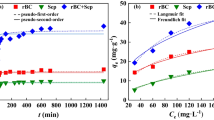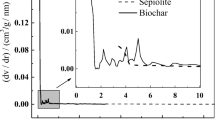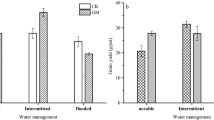Abstract
The in-situ immobilization effect of sepiolite and biochar on the compound pollution of cadmium (Cd) and atrazine in acid red soil of south China was studied. Results showed that in a certain concentration range, sepiolite and biochar can improve the germination rate, ensure normal growth and increase biomass of pakchoi, reduce the content of Cd in edible parts of pakchoi in different degrees and meet international standards, and restrain absorption of atrazine in pakchoi completely. Sepiolite was more effective than biochar for the immobilization of Cd, while biochar was more effective than sepiolite for the immobilization of atrazine. Combined application of sepiolite and biochar in soil contaminated by Cd and atrazine was better than individual applications of sepiolite or biochar. The remediation method applied in this research can effectively repair the acid red soil with combined pollution of Cd and atrazine in south China, while also providing ideas for in-situ remediation of farmland soil with combined pollution of pesticides and metals.



Similar content being viewed by others
References
Anastassiades M, Lehotay SJ, Stajnbaher D, Schenck FJ (2003) Fast and easy multiresidue method employing acetonitrile extraction/partitioning and dispersive solid-phase extraction for the determination of pesticide residues in produce. J AOAC Int 86:412–431
Brooks RR (1998) Plants that hyperaccumulate heavy metals. Centre for Agriculture and Biosciences International, Oxfordshire
Cao X, Harris W (2010) Properties of dairy-manure-derived biochar pertinent to its potential use in remediation. Bioresour Technol 101:5222–5228
Cedergreen N (2014) Quantifying synergy: a systematic review of mixture toxicity studies within environmental toxicology. PLoS ONE 9:e96580
Codex Alimentarius (1995) General standard for contaminants and toxins in food and feed. Publishing FAO and WHO. http://www.fao.org/fao-who-codexalimentarius/ thematic-areas/contaminants/en/. Accessed 24 Aug 2018
Fu PF, Yang HF (2015) Deep processing technology of nonmetal ore. Science Press, Beijing (in Chinese)
Hadibarata T, Kristanti RA (2012) Fate and cometabolic degradation of benzo[a]pyrene by white-rot fungus Armillaria sp. F022. Bioresour Technol 107:314–318
Hale SE, Hanley K, Lehmann J, Zimmerman AR, Cornelissen G (2011) Effects of chemical, biological and physical aging as well as soil addition on the sorption of pyrene to activated carbon and biochar. Environ Sci Technol 45:10445–10453
Hale SE, Jensen J, Jakob L, Oleszczuk P, Hartnik T, Henriksen T, Okkenhaug G, Martinsen V, Cornelissen G (2013) Short-term effect of the soil amendments activated carbon, biochar, and ferric oxyhydroxide on bacteria and invertebrates. Environ Sci Technol 47:8674–8683
Jiang J, Xu RK, Jiang TY, Li Z (2012) Immobilization of Cu(II), Pb(II) and Cd(II) by the addition of rice straw derived biochar to a simulated polluted Ultisol. J Hazard Mater 229–230:145–150
Kiran YK, Barkat A, Cui XQ, Feng Y, Pan FS, Tang L, Yang XE (2017) Cow manure and cow manure-derived biochar application as a soil amendment for reducing cadmium availability and accumulation by Brassica chinensis L. in acidic red soil. J Integr Agr 16:725–734
Li JR, Xu YM (2015) Immobilization of Cd in a paddy soil using moisture management and amendment. Chemosphere 122:131–136
Liang XF, Qin X, Huang QQ, Huang R, Yin XL, Wang L, Sun YB, Xu YM (2017) Mercapto functionalized sepiolite: a novel and efficient immobilization agent for cadmium polluted soil. RSC Adv 7:39955–39961
Lin Y, Cheng B, Shyu G, Chang T (2010) Combining a finite mixture distribution model with indicator kriging to delineate and map the spatial patterns of soil heavy metal pollution in Chunghua County, central Taiwan. Environ Pollut 158:235–244
Marques APGC, Rangel AOSS, Castro PML (2009) Remediation of heavy metal contaminated soils: phytoremediation as a potentially promising clean-up technology. Crit Rev Environ Sci Technol 39:622–654
Mohamed I, Zhang GS, Li ZG, Liu Y, Chen F, Dai K (2015) Ecological restoration of an acidic Cd contaminated soil using bamboo biochar application. Ecol Eng 84:67–76
Moore MT, Kröger R (2010) Effect of three insecticides and two herbicides on rice (Oryza sativa) seedling germination and growth. Arch Environ Contam Toxicol 59:574–581
Otitoloju AA (2002) Evaluation of the joint-action toxicity of binary mixtures of heavy metals against the mangrove periwinkle Tympanotonus fuscatus var radula (L.). Ecotox Environ Saf 53:404–415
Rafati M, Khorasani N, Moattar F, Shirvany A, Moraghebi F, Hosse inzadeh S (2011) Phytoremediation potential of Populus alba and Morus alba for cadmium, chromuim and nickel absorption from polluted soil. Int J Environ Res 5:961–970
Regmi P, Garcia Moscoso JL, Kumar S, Cao X, Mao J, Schafran G (2012) Removal of copper and cadmium from aqueous solution using switchgrass biochar produced via hydrothermal carbonization process. J Environ Manag 109:61–69
Shimabukuro RH (1967) Atrazine metabolism and herbicidal selectivity. Plant Physiol 43:1269–1276
Su YH, Zhu YG, Lin AJ, Zhang XH (2005) Interaction between cadmium and atrazine during uptake by rice seedlings (Oryza sativa L.). Chemosphere 60:802–809
Sun YB, Zhou QX, Wang L, Liu WT (2009) Cadmium tolerance and accumulation characteristics of Bidens pilosa L. as a potential Cd-hyper accumulator. J Hazard Mater 161:808–814
Sun YB, Sun GH, Xu YM, Wang L, Liang XF, Lin DS (2013) Assessment of sepiolite for immobilization of cadmium-contaminated soils. Geoderma 193–194:149–155
Sun YB, Xu Y, Xu YM, Wang L, Liang XF, Li Y (2016) Reliability and stability of immobilization remediation of Cd polluted soils using sepiolite under pot and field trials. Environ Pollut 208:739–746
Uwizeyimana H, Wang M, Chen W (2017) Evaluation of combined noxious effects of siduron and cadmium on the earthworm Eisenia fetida. Environ Sci Pollut R 24:5349–5359
Xu Y, Liang XF, Xu YM, Qin X, Huang QQ, Wang L, Sun YB (2017) Remediation of heavy metal-polluted agricultural soils using clay minerals: a review. Pedosphere 27:193–204
Zhang P, Sun H, Yu L, Sun TH (2013) Adsorption and catalytic hydrolysis of carbaryl and atrazine on pig manure-derived biochars: impact of structural properties of biochars. J Hazard Mater 244–245:217–224
Zhao YP, Tan YY, Guo Y, Gu XY, Wang XR, Zhang Y (2013) Interactions of tetracycline with Cd(II), Cu(II) and Pb(II) and their cosorption behavior in soils. Environ Pollut 180:206–213
Acknowledgements
This study was supported by the Transformation and Popularization Project of Agricultural Scientific and Technological Achievements of Tianjin, China (Project Number: 201502290). We thank Janani Sargunam for his linguistic assistance during the preparation of this manuscript.
Author information
Authors and Affiliations
Corresponding author
Rights and permissions
About this article
Cite this article
Qin, X., Liu, Y., Huang, Q. et al. In-Situ Remediation of Cadmium and Atrazine Contaminated Acid Red Soil of South China Using Sepiolite and Biochar. Bull Environ Contam Toxicol 102, 128–133 (2019). https://doi.org/10.1007/s00128-018-2494-2
Received:
Accepted:
Published:
Issue Date:
DOI: https://doi.org/10.1007/s00128-018-2494-2




